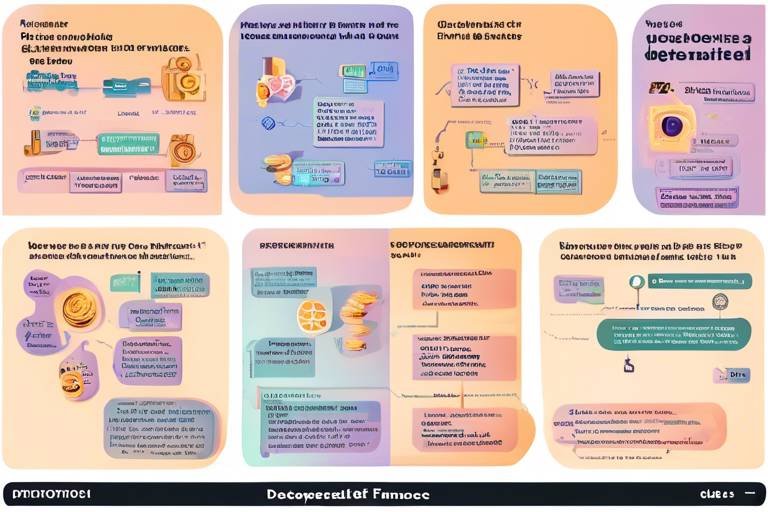The Role of Blockchain in Improving Air Travel Safety
In an age where air travel is a common mode of transportation, ensuring the safety of passengers and crew is paramount. With the advent of blockchain technology, the aviation industry is on the brink of a significant transformation. Imagine a world where every detail of your flight journey is securely documented, where the integrity of data is guaranteed, and where real-time tracking enhances safety protocols. This is not just a dream—it's the reality that blockchain promises. By leveraging its unique features, such as data integrity, transparency, and real-time tracking, the aviation sector can revolutionize its safety measures, providing a safer and more reliable flying experience for everyone involved.
One of the most compelling advantages of blockchain is its decentralized nature, which ensures that critical flight data remains unaltered. Think of it as a digital ledger that records every transaction or piece of information without the risk of tampering. For airlines and regulatory authorities, this means having access to a reliable source of information that can improve decision-making and safety protocols. In a world where data breaches and misinformation can lead to catastrophic consequences, the integrity of flight data is non-negotiable. By utilizing blockchain, airlines can trust that their data is accurate, leading to better safety outcomes.
Imagine being able to track an aircraft's movements in real-time, much like tracking a package on your favorite delivery app. Utilizing blockchain for real-time tracking allows airlines and regulatory bodies to monitor aircraft movements with unprecedented accuracy. This increased situational awareness not only enhances operational efficiency but also contributes to improved safety measures. In the event of an emergency, having instant access to an aircraft's location and status can be the difference between a safe landing and a disaster.
Maintenance records are the backbone of aviation safety. With blockchain, the process of keeping track of repairs and inspections becomes seamless. Imagine a system where every maintenance action is recorded in an immutable ledger, easily accessible to authorized personnel. This ensures that all repairs are documented accurately, reducing the risk of oversight and enhancing the safety of aircraft operations. When maintenance history is transparent and readily available, airlines can make better-informed decisions that prioritize passenger safety.
In an industry where security is paramount, blockchain can streamline the check-in process while ensuring secure and tamper-proof identity verification. Picture a world where passengers can verify their identities with a simple scan of their digital ID, eliminating the risk of fraud and enhancing overall safety. This not only speeds up the boarding process but also reassures passengers that their personal information is protected. By reducing the chances of identity theft, blockchain technology can significantly enhance the safety of air travel.
The aviation supply chain is complex, involving numerous stakeholders and countless components. Blockchain technology can improve the transparency and traceability of aviation supply chains, ensuring that only certified parts and materials are used in aircraft. This is crucial because the safety of an aircraft often hinges on the quality of its components. By utilizing blockchain, airlines can verify that every part meets stringent safety standards, ultimately enhancing aircraft safety.
Regulatory compliance is a critical aspect of airline operations. With blockchain, compliance processes can be automated, ensuring that all safety regulations are met and documented. This reduces the likelihood of human error and improves overall safety standards. Imagine a system where every safety check is logged automatically, providing a clear audit trail for regulators. This not only simplifies compliance for airlines but also builds trust with regulatory bodies.
In today's digital age, cybersecurity is more important than ever, especially in the aviation industry. Implementing blockchain can significantly enhance cybersecurity measures by providing secure data storage and transmission. Think of blockchain as a fortress protecting sensitive information from potential cyber threats. By safeguarding critical data, airlines can ensure that passenger information and operational details are kept safe from malicious actors.
Incident reporting is a vital component of aviation safety. Blockchain can facilitate a transparent and immutable incident reporting system, allowing for more accurate data collection and analysis. Consider the implications: when incidents are reported in real-time and cannot be altered, the data collected becomes a powerful tool for improving safety protocols and practices. This can lead to significant advancements in how the industry approaches safety, ultimately benefiting everyone involved.
The transparency offered by blockchain fosters trust among airlines, regulators, and passengers. When all stakeholders can access the same reliable information, it promotes a collaborative approach to safety improvements. This trust enhances the overall travel experience, as passengers feel more secure knowing that their safety is a shared priority among all parties involved. In a world where skepticism can run high, blockchain technology offers a beacon of hope for a safer future in air travel.
- What is blockchain technology? Blockchain is a decentralized digital ledger that records transactions across multiple computers, ensuring that the information is secure and unalterable.
- How can blockchain improve air travel safety? By enhancing data integrity, enabling real-time tracking, improving maintenance records, and streamlining passenger identification, among other benefits.
- Is blockchain secure? Yes, blockchain technology provides a high level of security through encryption and decentralized data storage, making it difficult for unauthorized users to alter information.
- Can blockchain help with regulatory compliance in aviation? Absolutely! Blockchain can automate compliance processes, ensuring that safety regulations are met and documented accurately.

Enhancing Data Integrity
This article explores how blockchain technology can enhance safety measures in air travel, addressing key areas such as data integrity, transparency, and real-time tracking to ensure a safer flying experience.
In an industry where every second counts and where the stakes are incredibly high, the integrity of data is paramount. Blockchain technology emerges as a game-changer by providing a decentralized and immutable ledger that guarantees the accuracy and reliability of critical flight data. Imagine the chaos that could ensue if flight data were to be tampered with—delays, accidents, and a complete breakdown of trust among airlines, regulators, and passengers. With blockchain, each piece of information, whether it’s flight schedules, maintenance logs, or safety checks, is recorded in a way that cannot be altered or deleted.
One of the key features of blockchain is its ability to create a single source of truth. This means that all stakeholders, including airlines, regulatory bodies, and maintenance crews, can access the same unchangeable data. For example, if an aircraft undergoes maintenance, the details are recorded on the blockchain. This record is visible to everyone involved, eliminating discrepancies that could lead to safety risks. The result? A more informed decision-making process that ultimately enhances safety protocols across the board.
To illustrate the importance of data integrity, consider the following table that outlines the potential consequences of data tampering in aviation:
| Type of Data | Potential Consequences of Tampering |
|---|---|
| Flight Schedules | Delays, cancellations, and passenger dissatisfaction |
| Maintenance Records | Increased risk of mechanical failure and accidents |
| Safety Checks | Compromised safety standards and regulatory violations |
Furthermore, the transparency provided by blockchain allows for real-time auditing of data. This means that any discrepancies can be spotted and addressed immediately, rather than after an incident occurs. Airlines can implement proactive measures to rectify issues before they escalate into serious problems. This level of vigilance is crucial in an industry where safety is non-negotiable.
In addition to enhancing data integrity, blockchain can also facilitate better communication among various stakeholders. By having a centralized, tamper-proof record, airlines can streamline their operations and ensure that everyone is on the same page. This collaborative approach not only improves operational efficiency but also builds a culture of accountability and trust.
In conclusion, the integration of blockchain technology into the aviation industry is not just a technological upgrade; it's a fundamental shift towards a safer flying experience. By ensuring data integrity, airlines can enhance safety measures, foster trust among stakeholders, and ultimately create a more reliable air travel environment.
- What is blockchain technology?
Blockchain is a decentralized digital ledger that records transactions across many computers in a way that the registered data cannot be altered retroactively. - How can blockchain improve air travel safety?
By enhancing data integrity, enabling real-time tracking, improving maintenance records, and ensuring regulatory compliance, blockchain can significantly bolster safety measures in aviation. - Is blockchain secure?
Yes, blockchain technology is designed to be highly secure, making it difficult for unauthorized individuals to alter or manipulate the data. - Can blockchain eliminate human error in aviation?
While it cannot completely eliminate human error, blockchain can automate many processes, reducing the chances of mistakes and improving overall safety standards.

Real-Time Tracking of Aircraft
In the fast-paced world of air travel, the need for real-time tracking of aircraft has never been more crucial. Imagine being able to monitor every single flight in the sky, knowing precisely where each aircraft is at any given moment. This is where blockchain technology steps in, revolutionizing the way we track aircraft movements. The decentralized nature of blockchain ensures that data is not only secure but also accessible to all relevant stakeholders, including airlines, regulatory bodies, and even passengers.
With traditional tracking systems, data can often be fragmented or delayed, leading to a lack of situational awareness. However, by utilizing blockchain, airlines can achieve a level of transparency that has previously been unattainable. This means that every flight's location, speed, and altitude can be updated in real-time, allowing for immediate responses to any potential issues. Imagine a scenario where a flight is deviating from its planned route due to unexpected weather conditions; with real-time tracking, airlines can swiftly reroute the aircraft to ensure passenger safety.
Moreover, the integration of blockchain with Internet of Things (IoT) devices can further enhance tracking capabilities. Sensors installed on aircraft can feed data directly into the blockchain, creating an immutable record of every flight. This not only aids in tracking but also contributes to better maintenance and operational decisions. For instance, if a sensor detects an anomaly in the aircraft's performance, this information can be logged instantly on the blockchain, alerting maintenance crews to take action before it becomes a safety risk.
Additionally, real-time tracking powered by blockchain can streamline communication between various stakeholders. In the event of an emergency, having access to accurate and up-to-date information can make all the difference. It allows air traffic control, airline operations, and emergency services to coordinate effectively, ensuring that the right measures are taken promptly. This level of collaboration is vital in maintaining the safety and security of air travel.
To summarize, the implementation of blockchain for real-time aircraft tracking not only enhances situational awareness but also fosters a culture of safety and accountability within the aviation industry. As we move forward, the combination of blockchain and real-time tracking will undoubtedly play a pivotal role in shaping the future of air travel safety.
- What is real-time tracking in aviation?
Real-time tracking refers to the ability to monitor an aircraft's location and status at any given moment using advanced technology, such as blockchain. - How does blockchain improve tracking?
Blockchain provides a secure, decentralized platform for storing and sharing flight data, ensuring that information is accurate and accessible to all stakeholders. - Can real-time tracking prevent accidents?
While it cannot prevent all accidents, real-time tracking enhances situational awareness and allows for quicker responses to potential issues, thereby improving overall safety.

Improving Maintenance Records
In the aviation industry, maintenance records are not just a bureaucratic necessity; they are a critical component of ensuring flight safety. Imagine boarding a plane knowing that every repair and inspection has been documented accurately and is easily accessible. This is where blockchain technology shines. By leveraging its decentralized and immutable nature, airlines can create a system where maintenance records are not only secure but also transparent and tamper-proof. This means that once a record is entered into the blockchain, it cannot be altered or erased, providing an unbreakable chain of accountability.
The traditional methods of maintaining aircraft records often involve a maze of paperwork and digital files scattered across various platforms. This can lead to inconsistencies, lost documents, and sometimes, critical information being overlooked. With blockchain, all maintenance activities—from routine inspections to major repairs—can be logged in a single, unified system. This not only enhances the accuracy of the records but also ensures that they are readily available for inspection by regulatory bodies, airline management, and even the aircraft manufacturers.
Moreover, blockchain can streamline the process of data sharing among different stakeholders. For instance, when an aircraft undergoes maintenance, the details can be instantly shared with all relevant parties, including airlines, maintenance crews, and regulatory authorities. This real-time access to information can significantly reduce the chances of human error, as everyone involved is working from the same verified data. Think of it as a digital ledger where every entry is a building block of trust and reliability in aircraft operations.
To illustrate the impact of blockchain on maintenance records, consider the following table that outlines the differences between traditional record-keeping and blockchain-enabled systems:
| Aspect | Traditional Record-Keeping | Blockchain-Enabled Record-Keeping |
|---|---|---|
| Data Integrity | Prone to errors and alterations | Immutable and secure |
| Accessibility | Fragmented and time-consuming | Instant and centralized |
| Accountability | Difficult to trace | Clear audit trail |
| Compliance | Manual and prone to oversight | Automated and verified |
The implications of these improvements are profound. Enhanced maintenance records not only contribute to the safety of individual flights but also foster a culture of proactive safety management within the aviation industry. Airlines can identify patterns in maintenance issues, leading to more informed decision-making regarding aircraft operations and safety protocols. This shift from a reactive to a proactive approach could be the key to preventing accidents and ensuring that passengers feel secure while flying.
In conclusion, the integration of blockchain technology into maintenance record-keeping represents a significant leap forward in the quest for safer air travel. By ensuring that all records are accurate, accessible, and secure, the aviation industry can enhance its safety measures, ultimately leading to a more trustworthy flying experience for everyone involved.
- How does blockchain improve maintenance records? Blockchain provides a secure and immutable way to log maintenance activities, ensuring accuracy and accountability.
- Can blockchain be integrated with existing systems? Yes, blockchain can be integrated with existing aviation management systems to enhance their capabilities.
- What are the benefits of accurate maintenance records? Accurate records lead to better safety management, compliance with regulations, and increased trust among stakeholders.

Enhancing Passenger Identification
Imagine walking through an airport where the check-in process is as smooth as butter. No long lines, no frantic searches for your ID, just a seamless experience that gets you on your way faster than you can say "boarding pass." This is the promise of blockchain technology in enhancing passenger identification. By leveraging the unique capabilities of blockchain, airlines can create a secure and tamper-proof system for verifying passenger identities, which not only speeds up the check-in process but also significantly reduces the risk of fraud.
In traditional systems, passenger identification often relies on a patchwork of databases and verification methods that can be vulnerable to errors and security breaches. However, blockchain's decentralized ledger provides a single source of truth that is both immutable and transparent. Each passenger's identity can be securely stored and verified against this ledger, ensuring that only authorized individuals board the aircraft. This not only enhances safety but also builds confidence among travelers, knowing that their personal information is protected.
Furthermore, the use of blockchain can streamline the entire travel experience. With a digital identity stored on the blockchain, passengers could check in using their smartphones, eliminating the need for physical documents. Imagine a world where you simply walk up to a kiosk, scan your face or fingerprint, and voilà! You're checked in. This level of convenience is not just a dream; it's a reality that blockchain can help bring to life.
Additionally, the integration of blockchain with biometric technologies can further enhance security. By combining biometric data—such as fingerprints or facial recognition—with blockchain, airlines can ensure that the person checking in is indeed the ticket holder. This dual-layered approach to identification significantly reduces the chances of identity theft and fraud, making air travel safer for everyone.
Moreover, the benefits extend beyond just the passengers. Airlines and regulatory bodies can access a real-time verification system that allows them to monitor and audit passenger identities efficiently. This transparency fosters a collaborative environment where all stakeholders, including security agencies, can work together to ensure a safer flying experience.
In conclusion, enhancing passenger identification through blockchain technology is not just about improving efficiency; it's about creating a safer, more trustworthy travel environment. As we move towards a future where air travel is increasingly digitized, the role of blockchain in ensuring secure and efficient passenger identification will be pivotal. This transformation not only benefits airlines and regulatory bodies but also enhances the overall experience for travelers, making air travel a more enjoyable and secure adventure.
- How does blockchain improve passenger identification?
Blockchain provides a secure and immutable platform for storing passenger identities, allowing for quick and reliable verification. - Can biometric data be integrated with blockchain?
Yes, integrating biometric data with blockchain enhances security by ensuring that the person checking in matches the identity stored on the blockchain. - What are the benefits of using blockchain for airlines?
Airlines can benefit from reduced fraud, streamlined check-in processes, and improved passenger trust through enhanced security measures.

Streamlining Supply Chain Management
In the complex world of aviation, the supply chain is akin to the circulatory system of an organism, delivering essential components and materials that keep the aircraft flying safely. Blockchain technology can revolutionize this supply chain by enhancing transparency and traceability, ensuring that every part used in an aircraft is certified and meets stringent safety standards. Imagine a system where every bolt, engine, and piece of electronic equipment has a digital fingerprint, securely recorded and easily accessed by all stakeholders involved. This level of transparency not only builds confidence among airlines but also assures passengers that the aircraft they are boarding is equipped with genuine and safe parts.
One of the most significant benefits of utilizing blockchain in supply chain management is the reduction of fraud and counterfeiting. The aviation industry has faced issues with counterfeit parts, which pose serious safety risks. By employing blockchain, every transaction related to a part—from manufacturing to installation—can be recorded on an immutable ledger. This means that if a part is found to be faulty or counterfeit, tracing its origin becomes a straightforward process. The ability to track the entire lifecycle of a component ensures that only genuine, high-quality materials are used in aircraft construction and maintenance.
Furthermore, blockchain can streamline the procurement process. Traditionally, the supply chain involves numerous intermediaries, each adding their own layer of complexity and potential for error. With blockchain, all parties—from manufacturers to airlines—can access the same information simultaneously. This real-time sharing of data reduces delays and miscommunication, leading to faster decision-making and improved operational efficiency. For instance, if an airline needs a specific part urgently, they can quickly verify its availability and source it directly from the manufacturer without unnecessary intermediaries.
To illustrate the impact of blockchain on supply chain management, consider the following table that outlines the key advantages:
| Advantage | Description |
|---|---|
| Transparency | All transactions are visible to authorized parties, reducing the risk of fraud. |
| Traceability | Easy tracking of parts from manufacturing to installation ensures safety and compliance. |
| Efficiency | Real-time data sharing minimizes delays and enhances decision-making processes. |
| Cost Reduction | Lower costs associated with intermediaries and reduced fraud-related losses. |
In conclusion, implementing blockchain technology in aviation supply chain management is not just a trend; it’s a necessary evolution towards a safer and more efficient industry. By ensuring that only certified parts are used and streamlining the procurement process, blockchain can significantly enhance the overall safety of air travel. As we move forward, the integration of this technology will likely become a standard practice, providing peace of mind to airlines and passengers alike.
Q: How does blockchain improve the traceability of aircraft parts?
A: Blockchain records every transaction related to aircraft parts on an immutable ledger, allowing for easy tracking and verification of the origin and history of each component.
Q: Can blockchain help reduce the risk of counterfeit parts in aviation?
A: Yes, by providing a transparent and secure record of all parts, blockchain minimizes the chances of counterfeit components entering the supply chain.
Q: What are the cost benefits of using blockchain in supply chain management?
A: Blockchain can reduce costs by eliminating intermediaries, minimizing fraud-related losses, and improving operational efficiency through real-time data sharing.

Facilitating Regulatory Compliance
In the world of aviation, regulatory compliance is not just a box to check; it's a vital component that ensures safety and efficiency across the board. With the increasing complexity of air travel regulations, blockchain technology emerges as a game-changer. Imagine a world where every safety regulation is automatically tracked and verified in real-time, reducing the burden on airlines and enhancing accountability. That's precisely what blockchain offers.
One of the most significant advantages of blockchain is its ability to create an immutable record of compliance activities. Every transaction or update made within the blockchain is time-stamped and cannot be altered or deleted. This feature alone could mitigate the risks associated with human error, which has historically plagued compliance processes. For instance, if an airline needs to prove that it conducted a mandatory safety inspection, it can simply provide the blockchain record without any room for dispute. This level of transparency not only boosts confidence among regulatory bodies but also reassures passengers that their safety is prioritized.
Furthermore, the automation capabilities of blockchain can significantly streamline compliance workflows. Instead of relying on manual processes that are often slow and prone to mistakes, airlines can utilize smart contracts—self-executing contracts with the terms of the agreement directly written into code. These smart contracts can automatically trigger compliance checks and alerts when certain conditions are met. For example, if a maintenance check is due, the system can notify the relevant personnel and log the completion of the task in real-time. This automation not only saves time but also ensures that no important safety checks fall through the cracks.
To illustrate how blockchain can facilitate regulatory compliance in aviation, consider the following table:
| Compliance Area | Traditional Method | Blockchain Method |
|---|---|---|
| Maintenance Records | Manual logs prone to errors | Immutable, real-time logs |
| Safety Inspections | Paper-based tracking | Automated alerts and logging |
| Regulatory Reporting | Periodic audits | Continuous, real-time compliance verification |
By implementing blockchain, airlines can not only meet regulatory requirements but also exceed them, setting a new standard for safety and accountability in the industry. Moreover, this technology fosters collaboration between airlines and regulatory agencies, as both parties can access the same data in real-time, ensuring that everyone is on the same page. This level of cooperation is essential in an industry where safety is paramount.
In conclusion, blockchain technology is not just a buzzword; it's a transformative tool that can significantly enhance regulatory compliance in air travel. By automating processes, providing immutable records, and fostering transparency, blockchain can help create a safer flying environment for everyone involved. As we move forward, embracing such innovative solutions will be crucial in navigating the complex landscape of aviation regulations.
- What is blockchain technology? Blockchain is a decentralized digital ledger that records transactions across many computers securely and transparently.
- How does blockchain improve regulatory compliance? It provides an immutable record of compliance activities and automates processes through smart contracts.
- Can blockchain reduce human error in aviation? Yes, by automating compliance checks and maintaining accurate records, blockchain minimizes the risk of human error.
- Is blockchain secure? Yes, blockchain offers enhanced security features that protect data from tampering and unauthorized access.

Boosting Cybersecurity Measures
In an age where cyber threats loom larger than ever, the aviation industry must prioritize cybersecurity to safeguard sensitive data and maintain passenger trust. Blockchain technology emerges as a robust solution, offering a decentralized framework that enhances the security of information storage and transmission. Imagine a digital fortress where every piece of data is locked away, only accessible to those with the right keys. This is what blockchain provides—a secure environment that significantly reduces the risk of data breaches.
One of the most significant advantages of blockchain is its immutable ledger. Each transaction or data entry is recorded in a way that cannot be altered or deleted, creating a permanent record of all activities. This feature is particularly crucial for airlines, which handle vast amounts of sensitive information, from passenger details to maintenance logs. By utilizing blockchain, airlines can ensure that any attempt to tamper with data will be immediately evident, thus deterring potential cybercriminals.
Furthermore, the decentralized nature of blockchain means that there is no single point of failure. Traditional databases are often vulnerable to attacks because they are centralized; if a hacker gains access, they can wreak havoc. In contrast, with blockchain, data is distributed across a network of computers, making it incredibly difficult for any unauthorized user to compromise the system. This decentralization not only enhances security but also improves data resilience, ensuring that critical information remains available even in the event of a cyber attack.
To illustrate the impact of blockchain on cybersecurity, consider the following table that outlines the key benefits:
| Benefit | Description |
|---|---|
| Data Integrity | Ensures that all records are accurate and unaltered. |
| Decentralization | Reduces the risk of a single point of failure. |
| Transparency | All transactions are visible and verifiable by authorized parties. |
| Enhanced Security | Protects sensitive information from unauthorized access. |
Moreover, blockchain can facilitate secure communications between various stakeholders in the aviation industry. By employing smart contracts—self-executing contracts with the terms of the agreement directly written into code—airlines can automate processes such as ticketing and baggage handling. This not only streamlines operations but also ensures that all transactions are secure and transparent, further mitigating the risk of fraud.
As we look to the future of air travel, it’s clear that the integration of blockchain technology into cybersecurity measures is not just beneficial; it’s essential. By fostering a secure environment for data handling, airlines can protect themselves from the ever-evolving landscape of cyber threats. In doing so, they not only enhance their operational efficiency but also build trust with passengers, ensuring that everyone can fly with peace of mind.
- What is blockchain technology? Blockchain is a decentralized digital ledger that records transactions across many computers in a way that the registered transactions cannot be altered retroactively.
- How does blockchain improve cybersecurity in aviation? By providing an immutable ledger and decentralizing data storage, blockchain significantly reduces the risk of data breaches and unauthorized access.
- Can blockchain prevent all cyber attacks? While blockchain enhances security, it cannot completely prevent all cyber attacks. It is a vital part of a broader cybersecurity strategy.
- What are smart contracts? Smart contracts are self-executing contracts with the terms directly written into code, allowing for secure and automated transactions.

Enhancing Incident Reporting
In the world of aviation, incidents can occur unexpectedly, and the way these incidents are reported and analyzed is crucial for improving safety protocols. Blockchain technology offers a transformative approach to incident reporting by creating a transparent and immutable system. Imagine a digital ledger where every incident is logged in real-time, accessible to all stakeholders involved—airlines, regulators, and even passengers. This level of transparency can lead to more accurate data collection and analysis, allowing for better understanding and management of safety risks.
One of the significant advantages of using blockchain for incident reporting is the reduction of human error. Traditional reporting systems often rely on manual input, which can lead to inaccuracies or even omissions. With blockchain, each entry is time-stamped and cannot be altered once recorded, ensuring that the information is both reliable and trustworthy. This is akin to having a diary where you can’t erase mistakes; instead, you learn from them and improve.
Additionally, the decentralized nature of blockchain means that no single entity has control over the data. This fosters a collaborative environment among airlines and regulatory bodies, encouraging them to share insights and learn from each other's experiences. When incidents are reported on a blockchain, they can be analyzed collectively, leading to industry-wide improvements in safety standards. For instance, if a particular maintenance issue is reported multiple times across different airlines, it can trigger a comprehensive investigation into the root cause, ultimately leading to better safety practices.
Furthermore, blockchain can streamline the incident reporting process by integrating with existing systems used by airlines and regulatory bodies. This means that when an incident occurs, the reporting can be automated, reducing the time it takes to log the event. Imagine a scenario where a pilot reports a technical issue, and within seconds, the information is recorded on a blockchain, alerting maintenance teams and regulators simultaneously. This rapid response capability can be critical in preventing further incidents and ensuring passenger safety.
To illustrate the potential of blockchain in enhancing incident reporting, consider the following table that outlines the key benefits:
| Benefit | Description |
|---|---|
| Transparency | All stakeholders can access the same information, fostering trust and collaboration. |
| Immutability | Once data is recorded, it cannot be altered, ensuring accuracy in reporting. |
| Reduced Human Error | Automated logging minimizes the chances of inaccuracies in incident reports. |
| Rapid Response | Real-time reporting allows for quicker action and resolution of safety issues. |
| Collective Analysis | Industry-wide data sharing leads to improved safety protocols and practices. |
In summary, enhancing incident reporting through blockchain technology not only improves the accuracy and reliability of safety data but also promotes a culture of transparency and collaboration within the aviation industry. As we move forward, leveraging this technology could very well be the key to achieving a new standard in air travel safety, where every incident is a lesson learned, and every flight is a step towards a safer future.
- How does blockchain improve incident reporting? Blockchain enhances incident reporting by providing a transparent, immutable, and decentralized system that reduces human error and allows for real-time data sharing.
- Can blockchain help in preventing future incidents? Yes, by analyzing data from reported incidents, airlines and regulators can identify patterns and take proactive measures to prevent similar issues in the future.
- Is the implementation of blockchain expensive? While there may be initial costs associated with implementing blockchain technology, the long-term benefits in safety and efficiency can outweigh these costs.

Building Trust Among Stakeholders
In the complex world of air travel, trust is not just a nice-to-have; it’s a critical necessity. Imagine stepping onto a plane, confident that every piece of information regarding your flight is accurate and up-to-date. This is where blockchain technology comes into play, acting as a digital ledger that is both transparent and immutable. By providing a tamper-proof record of transactions, blockchain fosters a sense of trust among all stakeholders involved—airlines, regulators, and passengers alike.
When airlines utilize blockchain, they can share real-time data with regulatory bodies, ensuring that all safety measures are not only met but also verified. This shared visibility helps to eliminate the common pitfalls of misinformation, where one party may be unaware of changes or updates that could impact safety. For example, if a maintenance record is updated on the blockchain, all stakeholders can see this change immediately, ensuring everyone is on the same page. This level of transparency is akin to having a clear window into the operational processes of airlines, where nothing is hidden, and everything is documented.
Furthermore, passengers benefit from this enhanced transparency as well. Imagine checking in at the airport, and instead of dealing with a cumbersome process, you are greeted with a seamless experience where your identity is verified through a secure blockchain system. This not only speeds up the check-in process but also significantly reduces the risk of identity fraud. When passengers see that airlines are investing in cutting-edge technology to protect their data, their trust in the airline increases exponentially.
In addition to improving trust between airlines and passengers, blockchain also strengthens the relationship between airlines and regulatory authorities. By automating compliance processes and providing a real-time audit trail, blockchain allows regulators to monitor safety standards effectively. This proactive approach to compliance means that airlines can quickly adapt to new regulations, making them more agile and responsive to changes in the aviation landscape. It’s like having a safety net that not only catches you when you fall but also helps you avoid falling in the first place.
Ultimately, the collaborative approach fostered by blockchain leads to an ecosystem where safety improvements are a shared responsibility. Airlines, regulators, and passengers all play a role in maintaining high safety standards, and the transparency provided by blockchain technology ensures that everyone is accountable. This collective effort not only enhances safety but also builds a resilient framework for trust that can withstand the challenges of the aviation industry.
- How does blockchain improve trust in air travel? Blockchain enhances trust by providing a transparent and immutable record of transactions, ensuring that all stakeholders have access to accurate and real-time information.
- Can blockchain prevent identity fraud in air travel? Yes, by utilizing secure identity verification processes, blockchain reduces the risk of identity fraud during check-in and boarding.
- What role do regulators play in the blockchain ecosystem? Regulators benefit from blockchain by gaining real-time visibility into compliance processes, which helps them monitor safety standards more effectively.
- Is blockchain technology widely adopted in the aviation industry? While still in its early stages, many airlines and aviation stakeholders are exploring and implementing blockchain solutions to enhance safety and efficiency.
Frequently Asked Questions
- How does blockchain enhance data integrity in air travel?
Blockchain technology ensures that critical flight data is decentralized and immutable, meaning that once information is recorded, it cannot be altered. This reliability provides airlines and authorities with a trustworthy source of information, allowing for better decision-making and improved safety protocols.
- What benefits does real-time tracking of aircraft offer?
By utilizing blockchain for real-time tracking, airlines can monitor aircraft movements more effectively. This enhances situational awareness for both airlines and regulatory bodies, contributing to improved safety measures and helping to prevent potential incidents.
- How can blockchain improve maintenance records for aircraft?
Blockchain streamlines the maintenance record-keeping process by ensuring that all repairs and inspections are accurately documented and easily accessible. This level of transparency enhances the safety of aircraft operations by providing a reliable history of maintenance activities.
- In what ways does blockchain enhance passenger identification?
Using blockchain for passenger identification simplifies the check-in process while ensuring that identity verification is secure and tamper-proof. This reduces the risk of fraud and enhances overall safety for both passengers and airlines.
- How does blockchain streamline supply chain management in aviation?
Blockchain technology improves the transparency and traceability of aviation supply chains, ensuring that only certified parts and materials are used in aircraft. This enhances safety by mitigating the risks associated with counterfeit or substandard components.
- Can blockchain help with regulatory compliance in the airline industry?
Yes! Blockchain can automate compliance processes for airlines, ensuring that all safety regulations are met and documented accurately. This helps reduce human error and improves overall safety standards in the aviation sector.
- How does blockchain boost cybersecurity measures in air travel?
Implementing blockchain enhances cybersecurity by providing secure data storage and transmission. This protects sensitive information from potential cyber threats, making air travel safer for everyone involved.
- What role does blockchain play in incident reporting?
Blockchain facilitates a transparent and immutable incident reporting system, allowing for more accurate data collection and analysis. This can lead to significant improvements in safety protocols and practices, ultimately enhancing air travel safety.
- How does blockchain help build trust among stakeholders in the aviation industry?
The transparency offered by blockchain fosters trust among airlines, regulators, and passengers. By promoting a collaborative approach to safety improvements, it enhances the overall travel experience for everyone.



















